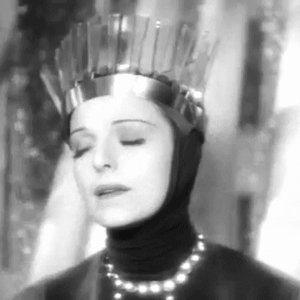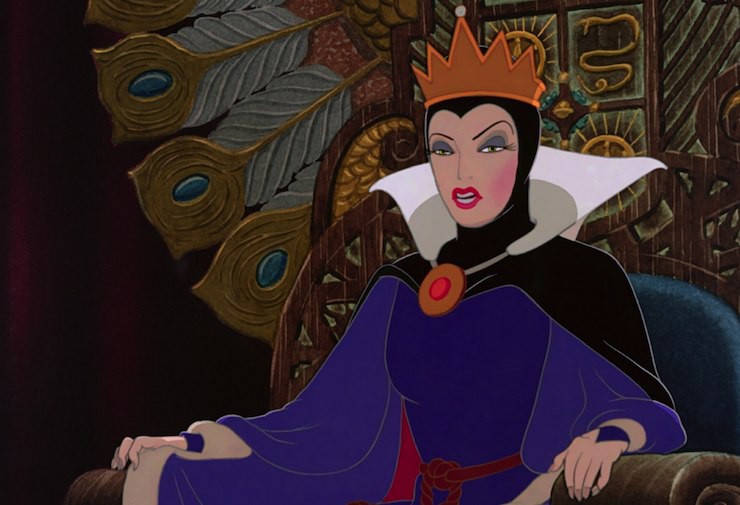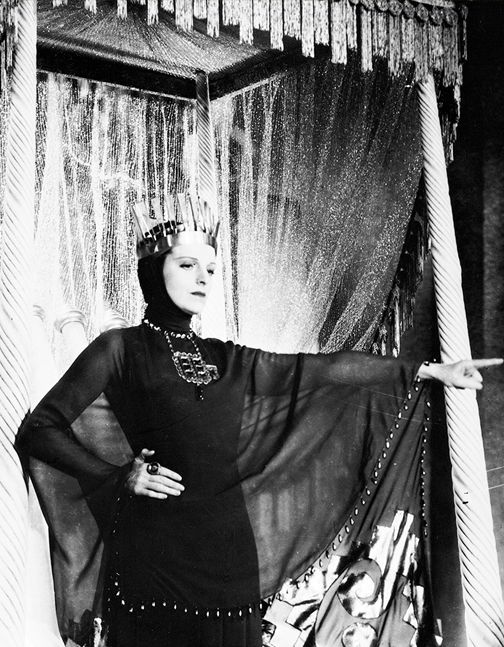There are few Disney villains more iconic than the Evil Queen from the 1937 animated feature Snow White and the Seven Dwarfs. She was the first, after all, and persists as a vivid and malignant presence in the studio’s pantheon to this day. Perhaps this is unsurprising when one plumbs her little-explored lineage, traceable to another of film and literature’s most enduring villainesses: Queen Ayesha of H. Rider Haggard’s 1887 novel She: A History of Adventure, a timeless, deathless being of unsurpassed beauty—the fairest in the land—who reigns cruelly over a lost African kingdom.
The indelible image of Disney’s Evil Queen adorned in her trademark crown, prominent bejeweled necklace and, most strikingly, severe black wimple is on display in countless Disney Studios spin-offs, all the way up to last year’s Disney Channel movie Descendants. It is, however, first seen in the 1935 film adaptation of She from producer Merian C. Cooper, the creative force behind King Kong (whose personal life reads like that of the Haggard hero Allan Quatermain from King Solomon’s Mines).
Though the Ayesha of Haggard’s novel is chronologically preceded by the nameless Queen of the original Grimms’ Fairy Tales story (1812), the iconic costume worn by Helen Gahagan Douglas, the actress who portrayed Hash-A-Mo-Tep (“She-who-must-be-obeyed”) in Cooper’s She, is frequently singled out as inspiration for the Disney rendition. Disney historian J.B. Kaufman attests to this, as do Harlan Ellison in his book Stalking the Nightmare and Brian J. Robb in A Brief History of Walt Disney.
The era’s Walt Disney Animation Studios staff, including Snow White and the Seven Dwarfs animator Art Babbitt, have historically denied this, though some of the sartorial similarities to Gahagan’s regalia (black gown, crown, pendant, and headwear), in the scene where She metes out her own brand of justice to “red-hot pot” cannibal natives, are difficult to disown. Aline Bernstein and Harold Miles are credited with costume design on the 1935 She, with the latter of the two serving as an art director on—dramatic pause—Disney’s Snow White and the Seven Dwarfs.
Walt Disney, for his part, described his Evil Queen as a cross between Lady Macbeth and the Big Bad Wolf, but a long list of inspirations, alleged and otherwise, went into the design of the Evil Queen—Princess Kriemhild from the 1924 Fritz Lang film Die Nibelungen was cited, perhaps explaining her unofficial Disney moniker “Queen Grimhilde,” as well as the Naumburg Cathedral statue of the medieval German noblewoman Uta von Ballenstedt. The result is a cauldron of influences concocted as assiduously and insidiously as the poison the Queen brews for innocent Snow White.
Whether coincidental or not, a few surface similarities exist beyond the crown and couture of the She of the Haggard novel and Disney’s classic. Though a Queen of Africa, ageless Ayesha is described as an Arabian “white as snow,” her Disney counterpart proving no match in the end for the true Snow White, “the fairest of them all.” Not unlike Disney’s Evil Queen glaring into her Magic Mirror, Haggard’s Ayesha can gaze “into the water, and there, mirrored upon its placid surface,” spy distant images, like a televisor screen in a Flash Gordon serial: “With an impatient gesture she passed her hand over the water once more. It darkened, and the image vanished silently and once more the lamplight, and the lamplight only, shone on the placid surface of that limpid, living mirror.”
In Cooper’s motion picture, the tropical Dark Continent setting is relocated to the Arctic, its wicked witch-queen recast as a wintry ice goddess. Before Elsa in Frozen, Disney Studios sometimes called their Snow White villainess “the Snow Queen,” and a number of literary critics and scholars believe that C. S. Lewis drew from Haggard for his White Witch, the Empress Jadis, in The Lion, the Witch, and the Wardrobe (turned into a 2005 live feature by Walt Disney Pictures) and The Magician’s Nephew. Lewis’ essay “The Mythopoeic Gift of H. Rider Haggard” (collected in the volume On Stories: And Other Essays on Literature) proves his reserved admiration for Haggard, if not any acknowledgement of Ayesha as his White Witch muse.

Eternal Ayesha eventually spawned a cycle of stories from Haggard (Ayesha: The Return of She, She and Allan, and Wisdom’s Daughter) and close to a dozen feature films, including the Georges Méliès 1899 version The Pillar of Fire (now lost) and Hammer’s 1965 She with Ursula Andress in the title role. Her influence is felt upon pulp characters such as Robert E. Howard’s Nakari of Negari in “The Moon of Skulls” and Edgar Rice Burroughs’ La from the Tarzan novels (beginning with The Return of Tarzan). She haunted the psyches of Sigmund Freud and Carl Jung, the early pioneers of psychoanalysis, and she may well have stuck in the conscious or unconscious Disney imagination before finding expression in history’s first feature-length animated movie.
“I am yesterday, and today, and tomorrow,” declares Helen Gahagan’s archetypal She about her own malevolent majesty. Yesterday, today, tomorrow—and forever.
The 1935 She is available as a DVD from Legend Films, and Snow White and the Seven Dwarfs in Blu-ray and DVD formats from the Disney Store.
Gilbert Colon has written for Filmfax, Cinema Retro, Film.Music.Media, Crimespree Magazine, Crime Factory, The New York Review of Science Fiction, and several other publications. Additionally, he interviewed Tor editor Greg Cox and Tor.com contributor Matthew R. Bradley for SF Signal, as well as filmmaker Abel Ferrara for the Stark House Press book Invasion of the Body Snatchers: A Tribute. At present he is a contributor-at-large to Marvel University and bare•bones e-zine, both headed by former Scream Factory editor Pete Enfantino. Read him at Gilbert Street and send comments to [email protected].











